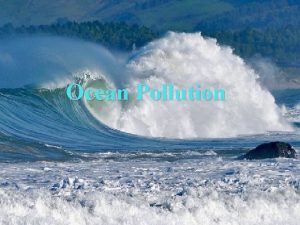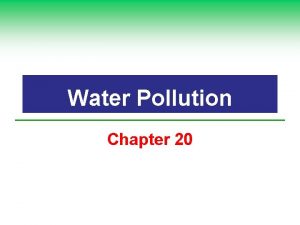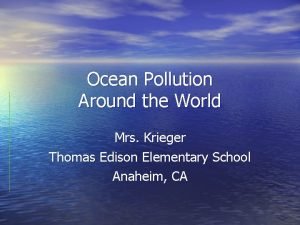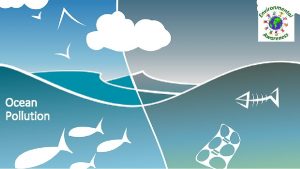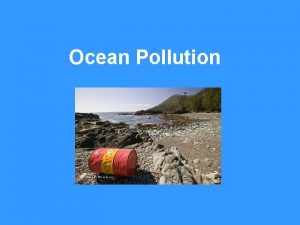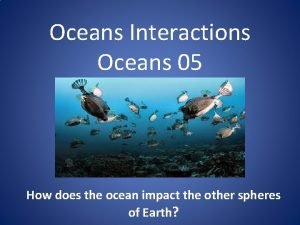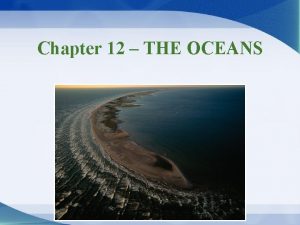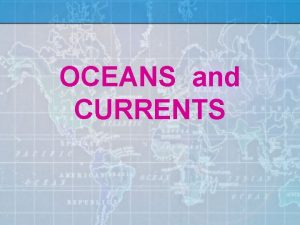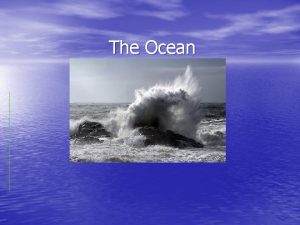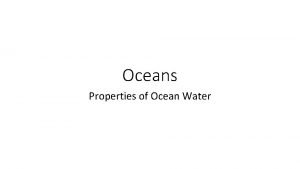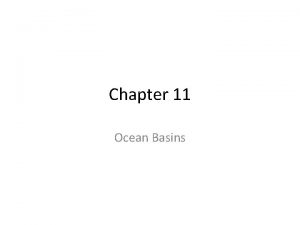OCEAN POLLUTION How Pollution Gets into the Oceans











- Slides: 11

OCEAN POLLUTION

How Pollution Gets into the Oceans • At least 85% of ocean pollution comes from activities on the land. • Pollution can enter rivers and be carried downstream near coasts where sensitive coastal environments like reefs and estuaries (where streams and rivers empty into coastal waters) are the hardest hit. • The rest of ocean pollution can be attributed to pollutants being deliberately dumped into ocean waters.

Pollutants get into oceans by one of several ways… • Pollutants like sludge (wastewater treatment by-product) and the wastewater or garbage from Ocean-liners can be dumped directly into the oceans. • Accidental oil spills such as the 1989 Exxon Valdez oil spill at Prince William Sound, Alaska. About 5% of oil spills happen in open ocean, the rest usually occur during the loading and unloading of oil. Plastic is a SERIOUS type of oceanic pollution. Fishing lines entangle and strangle marine life. Turtles suffocate by eating clear plastic bags thinking they are jellyfish. Sixpack plastic rings strangle sea birds and cut fish.

The Great Pacific Garbage Patch (Trash Vortex) • The Great Pacific Garbage Patch, also described as the Eastern Garbage Patch or the Pacific Trash Vortex is an area of marine debris in the central North Pacific Ocean located roughly in an area between 135° to 155°W and 35° to 42°N. The patch is characterized by exceptionally high concentrations of suspended plastic and other debris that have been trapped by the currents of the North Pacific Gyre. www. wikipedia. org

The Great Pacific Garbage Patch (Trash Vortex) • Like other areas of concentrated marine debris in the world's oceans, the Eastern Garbage Patch has formed gradually over the last decades as a result of higher levels of marine pollution and the action of prevailing oceanic currents. • The rotational pattern of the North Pacific Gyre draws in waste material from the reaches of the North Pacific Ocean, including the coastal areas of North America and Japan. • As material circulates in the current, wind-driven surface currents gradually move floating debris toward the center, trapping it in the circular oceanic region.

www. sailworld. com

The Great Pacific Garbage Patch (Trash Vortex) • It is estimated that 80% of the garbage comes from landbased sources, and 20% from ships at sea. • Currents carry debris from the east coast of Asia to the center of the gyre in a year or less, and debris from the west coast of North America in about five years. • For every pound of plankton, there are 6 pounds of garbage… maybe over 100 million tons (1 T=2204 lbs) • The size is somewhere between 1% and 8% of the entire Pacific Ocean! • CBC News Clip on North Pacific Gyre and Plastic Pollution http: //www. cbsnews. com/stories/2004/01/06/eveningnews/main 591770. shtml

G Word Clip on Trash Vortex – http: //planetgreen. discovery. com/tv/g-word/ocean-trash. html

Preventing Ocean Pollution • MARPOL or the International Convention for the Prevention of Pollution from Ships, prohibits the discharge of oil and plastic in oceanic and coastal environments. • The 1974 Helsinki Convention signed by 120 countries seeks to control land-based pollution such as toxic dumping, runoff and discharge of raw wastewater into oceans. This agreement has also created 15 marine refuges for endangered marine species, like the sea turtle. • It is very difficult to monitor every ship and the success of these laws and conventions depends on all nations obeying the laws and honouring the agreements.

Who Owns the Oceans? • The Law of the Sea Treaty (signed by 134 countries except the USA) gives countries control over 22 km of water extending from their coastlines. This area is called the “territorial sea”. Up to 370 km of water is considered a country’s exclusive economic zone. • The rest of the ocean is considered a communal property good which falls under the International Seabed Authority.

Questions • What is the major kind of ocean pollution, point or nonpoint? • How can plastic be eliminated from the oceans? • Identify three things YOU could do at home to decrease ocean pollution.
 The atlantic ocean gets about 3-5 ______ wider each year.
The atlantic ocean gets about 3-5 ______ wider each year. Red and blue ocean strategy
Red and blue ocean strategy Convergent boundaries features
Convergent boundaries features Chapter 15 ocean water and ocean life
Chapter 15 ocean water and ocean life Ocean ocean convergent boundary
Ocean ocean convergent boundary Scrat s continental crack up
Scrat s continental crack up Convergent boundary
Convergent boundary Ocean to ocean convergent boundary
Ocean to ocean convergent boundary Ocean ocean convergent boundary
Ocean ocean convergent boundary Ocean pollution
Ocean pollution Ocean pollution
Ocean pollution Ocean pollution
Ocean pollution









